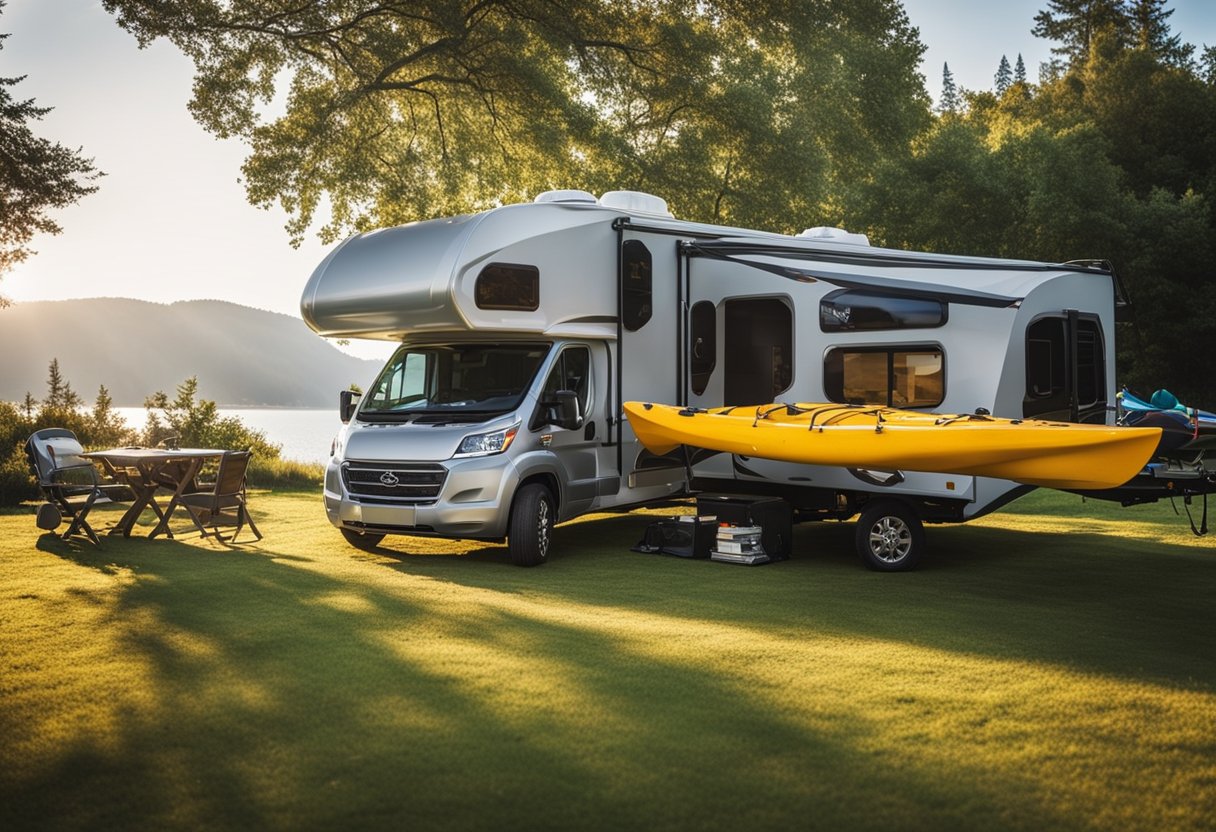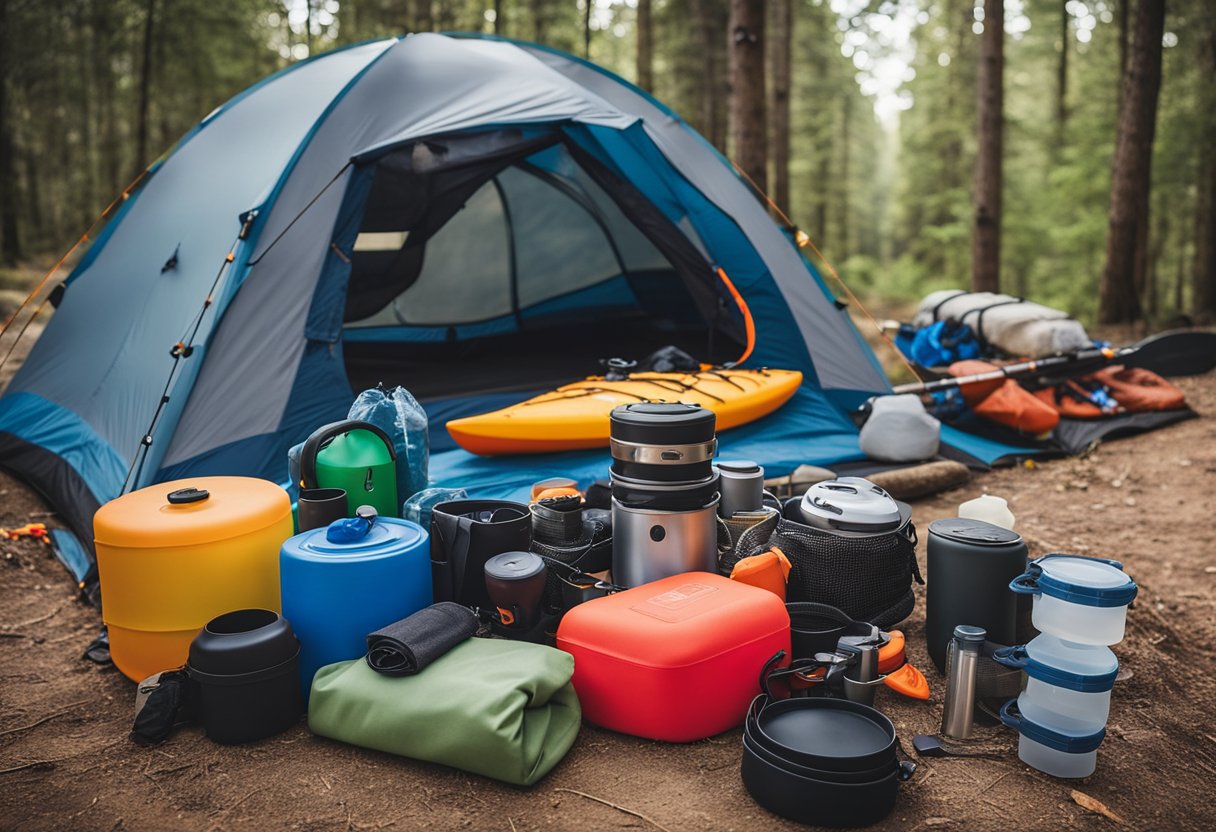Towing a kayak behind an RV can be a great way to explore new waterways while on a road trip. However, it’s important to ensure that you have the right equipment and follow safety guidelines to prevent accidents and damage to your kayak. In this article, we’ll provide some tips for selecting the right kayak towing equipment and how to safely tow your kayak behind your RV.

First and foremost, it’s important to invest in a high-quality kayak trailer or rack that is specifically designed for towing behind an RV. These trailers and racks are typically more sturdy and durable than standard kayak trailers, and are designed to withstand the bumps and vibrations of the road. Additionally, they often have features such as locking mechanisms and tie-down straps to keep your kayak secure during transit.
When towing your kayak, it’s also important to follow safety guidelines to prevent accidents and damage to your kayak. Always ensure that your kayak is properly secured to the trailer or rack, and that the trailer or rack is securely attached to your RV. Additionally, be sure to check the weight limits and towing capacity of your RV to ensure that you’re not exceeding its capabilities. By following these tips and guidelines, you can safely and confidently tow your kayak behind your RV and enjoy all the amazing waterways that the country has to offer.
Understanding the Basics of Towing Kayaks
When it comes to towing kayaks behind an RV, it’s important to understand the basics of equipment and safety. Here are some key things to keep in mind.
Types of Kayaks Suitable for Towing
Not all kayaks are suitable for towing behind an RV. It’s important to choose a kayak that is designed for this purpose. Here are some features to look for:
- Lightweight: A lightweight kayak is easier to tow and won’t put as much strain on your RV’s towing capacity.
- Durable: Your kayak should be able to withstand the rigors of being towed on the highway, including wind, rain, and debris.
- Streamlined: A kayak with a streamlined shape will be easier to tow and won’t create as much drag.
Towing Capacity and RV Specifications
Before you tow a kayak behind your RV, it’s important to make sure that your RV is equipped for the job. Here are some things to consider:
- Towing capacity: Make sure that your RV has enough towing capacity to safely tow a kayak. Check your owner’s manual for towing capacity specifications.
- Hitch type: You’ll need a hitch that is designed for towing kayaks. A standard ball hitch may not be sufficient.
- Brake controller: If your kayak weighs more than 1,500 pounds, you’ll need a brake controller to help you stop safely.
By understanding the basics of towing kayaks, you can ensure that your equipment is safe and secure while you’re on the road.
Essential Towing Equipment

When towing kayaks behind an RV, having the right equipment is essential for a safe and successful trip. Here are some key pieces of equipment that every kayaker should have:
Towing Hitches and Receivers
A sturdy towing hitch and receiver are essential for towing kayaks behind an RV. A Class III or Class IV hitch is recommended, as it can handle the weight of the kayaks and provide a secure attachment point. It’s important to make sure that the hitch and receiver are properly installed and rated for the weight of the kayaks.
Kayak Trailers and Racks
Kayak trailers and racks are another important piece of equipment for towing kayaks behind an RV. Trailers are a good option for those who have multiple kayaks or need to transport other gear, while racks are a better choice for those who have limited space or only need to transport one or two kayaks. It’s important to choose a trailer or rack that is designed specifically for kayaks and can safely secure them during transport.
Safety Cables and Straps
Safety cables and straps are essential for securing the kayaks to the trailer or rack and preventing them from shifting or falling off during transport. It’s important to choose high-quality cables and straps that are rated for the weight of the kayaks and can withstand the rigors of travel. It’s also important to inspect the cables and straps regularly to ensure that they are in good condition and replace them if necessary.
By having the right towing equipment, kayakers can enjoy a safe and stress-free trip while towing their kayaks behind an RV.
Pre-Trip Preparation

Before towing a kayak behind an RV, it is important to properly prepare for the trip to ensure safety and avoid any potential damage to the equipment. This section will cover the key steps to take in pre-trip preparation, including securing the kayak for transport, inspecting towing equipment, and planning the route.
Securing the Kayak for Transport
Properly securing the kayak for transport is crucial to prevent it from shifting or falling off during the trip. The following steps should be taken to secure the kayak:
- Use high-quality tie-down straps made specifically for kayaks to secure the boat to the roof rack or trailer.
- Use bow and stern lines to prevent the kayak from moving forward or backward.
- Use foam blocks or cradles to cushion the kayak and prevent it from getting scratched or damaged.
Inspecting Towing Equipment
Before hitting the road, it is important to inspect all towing equipment to ensure that it is in good condition and functioning properly. The following items should be checked:
- The hitch and ball should be securely attached and not showing any signs of wear or damage.
- The safety chains should be properly attached and not dragging on the ground.
- The brake controller should be tested to ensure that it is working properly.
Planning Your Route
Planning the route ahead of time can help avoid any potential hazards or obstacles that may be encountered while towing the kayak. The following steps should be taken when planning the route:
- Use maps or GPS to plan the most direct and safe route.
- Avoid roads with low clearances or weight restrictions that may not be suitable for towing.
- Plan rest stops along the way to allow for breaks and to check on the kayak and towing equipment.
By following these pre-trip preparation steps, RVers can help ensure a safe and enjoyable kayaking adventure.
On the Road Safety Tips

When towing a kayak behind an RV, it is important to keep safety in mind at all times. Here are some tips to ensure a safe and enjoyable journey.
Driving Techniques for Safe Towing
When towing a kayak, it is important to maintain a safe speed and keep a safe distance from other vehicles. The driver should also be aware of the kayak’s weight and size, and adjust their driving accordingly. When stopping, the driver should brake gently to avoid sudden jolts that could damage the kayak.
Understanding Towing Laws and Regulations
Before hitting the road, it is important to understand the towing laws and regulations in the state or province you will be traveling through. This includes knowing the maximum size and weight limits for your RV and kayak, as well as any special permits or licenses that may be required.
Dealing with Crosswinds and Turbulence
Crosswinds and turbulence can be a major challenge when towing a kayak behind an RV. To minimize the risk of accidents, it is important to adjust your driving speed and direction to compensate for these factors. Additionally, it may be helpful to use specialized equipment such as sway bars or stabilizers to help keep the kayak steady while on the road.
By following these tips, drivers can ensure a safe and enjoyable journey when towing a kayak behind an RV.
Maintenance and Storage

Post-Trip Equipment Checks
After a long trip towing kayaks behind an RV, it is important to perform a thorough post-trip equipment check. This will help ensure that your gear is in good condition and ready for the next adventure. Start by inspecting the kayak itself for any signs of damage, such as cracks or dents. Check the straps and tie-downs for wear and tear, and make sure they are still securely fastened to the kayak and the RV. Check the hitch and towing system for any signs of damage or wear. If you notice any issues, it is best to address them before your next trip.
Proper Storage of Towing Gear
Proper storage of your towing gear is essential to ensure that it remains in good condition and ready for use. After each trip, rinse off any saltwater or debris from the kayak and straps, and allow them to dry completely before storing them. Store the kayak in a cool, dry place, away from direct sunlight. Hang the straps and tie-downs on a hook or pegboard to keep them organized and prevent them from becoming tangled.
Routine Maintenance Schedule
To keep your towing gear in top condition, it is important to follow a routine maintenance schedule. This may include regular inspections, cleaning, and lubrication of the hitch and towing system. Check the kayak and straps for any signs of wear or damage, and replace them as needed. Follow the manufacturer’s recommendations for any other maintenance tasks, such as lubricating the ratchets on the tie-downs.
By following these maintenance and storage tips, you can help ensure that your towing gear remains in good condition and ready for your next kayaking adventure.
Emergency Procedures

Handling Breakdowns and Accidents
When towing kayaks behind an RV, there is always a risk of breakdowns and accidents, especially when traveling long distances. It is important to know how to handle these situations to avoid further damage or injury.
If the RV breaks down while towing kayaks, the first step is to find a safe place to pull over. Turn on the hazard lights and put out warning triangles or flares to alert other drivers. Check the kayaks for any damage and secure them properly to avoid any further damage.
In the event of an accident, the safety of all involved should be the top priority. Call emergency services immediately if anyone is injured. Check the kayaks for damage and make sure they are secured properly to prevent further damage. Take photos of the accident scene and exchange insurance information with the other party involved.
First Aid and Safety Equipment
It is important to have first aid and safety equipment on board when towing kayaks behind an RV. This includes a first aid kit, life jackets, and a fire extinguisher.
The first aid kit should include bandages, antiseptic, gauze, and other basic medical supplies. Life jackets should be worn by all kayakers at all times, and should be properly fitted to each individual. The fire extinguisher should be easily accessible and regularly checked to ensure it is in good working condition.
It is also important to have a basic tool kit on board to handle any minor repairs that may be needed. This should include a wrench, pliers, screwdrivers, and other basic tools.
By following these emergency procedures and having the necessary safety equipment on board, towing kayaks behind an RV can be a safe and enjoyable experience for everyone involved.




